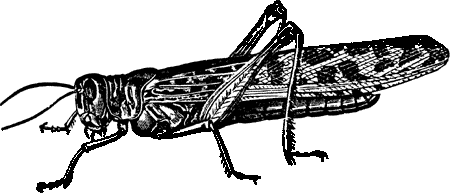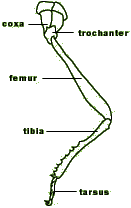
The Thorax

The thorax of the grasshopper is partially covered by a strong shield and by the wings. Its thorax is divided into three segments and each segment bears a pair of legs. The legs look not unlike the legs of a crustacean and have a series of joints (see illustration) and come to an end with two curved claws. Between these claws is a spongey pad which helps the grasshopper keep its footing on surfaces. It also allows it to grasp little things. The forward two pair of legs are the standard insect legs used for walking. Pretty average. The last pair, however, are special. They are specialized for jumping, and boy do they work. They have one joint called the femur and it contains muscles for jumping and is enlarged out of proportion to the others. Connected also to the thorax are the grasshoppers two pairs of wings. The pairs differ. The first pair serves not for flight, but as a cover for the hind wings. It is the hind wings that do all of the flying, really. They are broad during flight, but fold up nicely under the first pair. The differing wings is an attribute somewhat unique to the grasshopper. In most insects, the two pairs of wings are similar and both are used in flight.